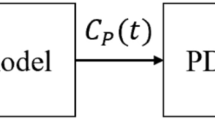Summary
The effects of midazolam on the EEG were related to plasma midazolam concentrations in 8 healthy male volunteers in order to develop a pharmacokinetic-pharmacodynamic model. The EEG parameters were derived by aperiodic analysis.
The EEG was recorded between Fp1-M1 and FP2-M2. Following a 15-minute baseline EEG registration, midazolam 15mg was given intravenously over 5 minutes. Venous blood samples were taken until 8 hours after the start of the infusion. Within 2 to 4 minutes of starting the infusion all subjects became asleep, with loss of eyelid reflex. The most obvious EEG changes, in the β frequency range (12 to 30Hz), were observed within 2 minutes of the start of drug administration. Seven subjects awoke 60 to 70 minutes after the start of the infusion and 1 awoke after 45 minutes.
The EEG parameter that best characterised the effect of midazolam was the total number of waves per second in the frequency range 12 to 30Hz (TNW12–30). This was used as the effect parameter in the pharmacokinetic-pharmacodynamic modelling. The plasma concentration-time data were characterised by a triexponential function for all subjects. To allow for a possible delay between plasma midazolam concentration and EEG effect, a hypothetical effect compartment was included in the pharmacokinetic-pharmacodynamic model. A sigmoid maximum effect (Emax) model was used to characterise the effect compartment midazolam concentration-TNW2–30 data. The plasma drug concentration corresponding to half the maximum increase in TNW12–30 (EC50) was 290 ± 98 μg/L. The half-life reflecting equilibration between plasma concentration and effect (t 00BDkeo) was estimated by a nonparametnc method and was 1.7 ± 0.7 minutes (mean ± SD).
The concentration at which the volunteers awoke was 131 ± 14 Mg/L. The EEG had returned to the baseline value 3 hours after the start of the infusion; at this time the plasma midazolam concentration was 60 ± 9 μg/L.
The conclusion is reached that, in volunteers, the effect of midazolam on the EEG can be quantified and adequately described with a sigmoid Emax model. TNW12–30, a parameter derived from aperiodic analysis of the EEG, is a suitable, and possibly superior, alternative to psychomotor tests for the assessment of the central nervous system effects of this drug.
Similar content being viewed by others
References
Allonen H. Zieglcr G, Klotz U. Midazolam kinetics. Clinical Pharmacology and Therapeutics 30: 653–661. 1981
Boxenbaum HG. Riegelman S. Elashoff RM. Statistical estimations in pharmacokinetics. Journal of Pharmacokinetics and Biopharmaceulics 2: 123–148. 1974
Brown CR. Sanquist FH. Canup CA. Pedley TA. Clinical electroencephalographic and pharmacokinetic studies of a watersoluble benzodiazepine, midazolam maleate. Anesthesiology 50: 467–470. 1979
Buhrer M, Maitre PO. Crevoisier C. Hung O, Stanski DR. Comparative pharmacokinetics of midazolam and diazepam. Anesthesiology 69: A 642. 1988
Crevoisier C Ziegler WH. Eckert M. Heizmann P. Relationship between plasma concentration and effect of midazolam after oral and intravenous administration. British Journal of Clinical Pharmacology 16: 51S–61S, 1983
Fuseau E. Sheiner LB. Simultaneous modelling of pharmacokinetics and pharmacodynamics with a non-parametric pharmacodynamic model. Clinical Pharmacology and Therapeutics 35: 733–741. 1984
Gregory TK. Pettus DC. An electroencephalographic processing algorithm specially intended for analysis of the cerebral activity. Journal of Clinical Monitoring 2: 190–197. 1986
Jasper HH. The ten twenty electrode system of the International Federation. Electroencephalography and Clinical Neurophysiology 10: 371–375. 1958
Kellaway P. An orderly approach to visual analysis: parameters of the normal EEG in adults and children. In Klass & Paly (Eds) Current practice of clinical electroencephalography pp. 69–143. Raven Press, New York, 1979
Klotz U. Ziegler G. Ludwig L, Reimann IW. Pharmacodynamic interaction between midazolam and a specific benzodiazepine antagonist in humans. Journal of Clinical Pharmacology 25: 400–406, 1985
Koopmans RP. Dingemanse J. Danhof M, Horsten GPM. van Boxtel CJ. Pharmacokinetic-pharmacodynamic modelling of midazolam effects on the human central nervous system. Clinical Pharmacology and Therapeutics 44: 14–22. 1988
Merlo F. Lion P. Study of the rapid EEG activity induced by midazolam. Current Therapeutic Research 38: 798–807, 1985
Persson MP, Nilsson A, Hartrig P. Relation of sedation and amnesia to plasma concentrations of midazolam in surgical patients. Clinical Pharmacology and Therapeutics 43: 324–331, 1988
Stanski DR. Hudson RJ, Homer TD, Saidman U. Meathe E. Pharmacodynamic modelling of thiopental anesthesia. Journal of Pharmacokinetics and Biopharmaceutics 12: 223–240, 1984
Author information
Authors and Affiliations
Rights and permissions
About this article
Cite this article
Breimer, L.T.M., Hennis, P.J., Burm, A.G.L. et al. Quantification of the EEG Effect of Midazolam by Aperiodic Analysis in Volunteers. Clin Pharmacokinet 18, 245–253 (1990). https://doi.org/10.2165/00003088-199018030-00006
Published:
Issue Date:
DOI: https://doi.org/10.2165/00003088-199018030-00006




